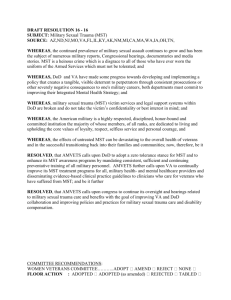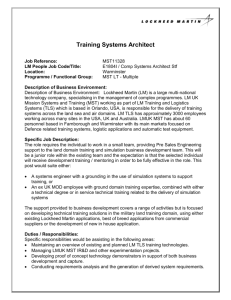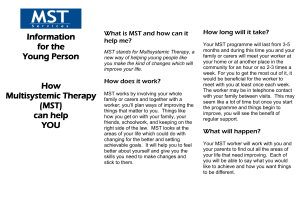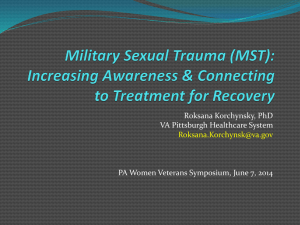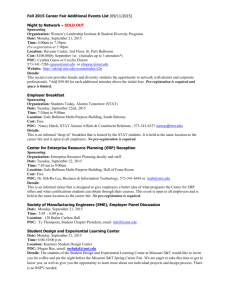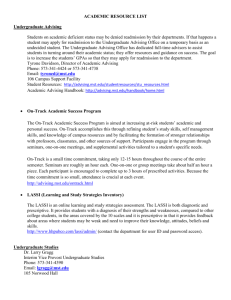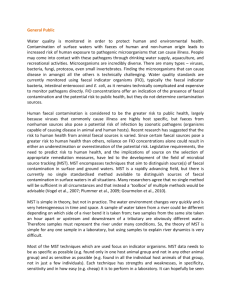Addressing Military Sexual Trauma in a Community Setting
advertisement
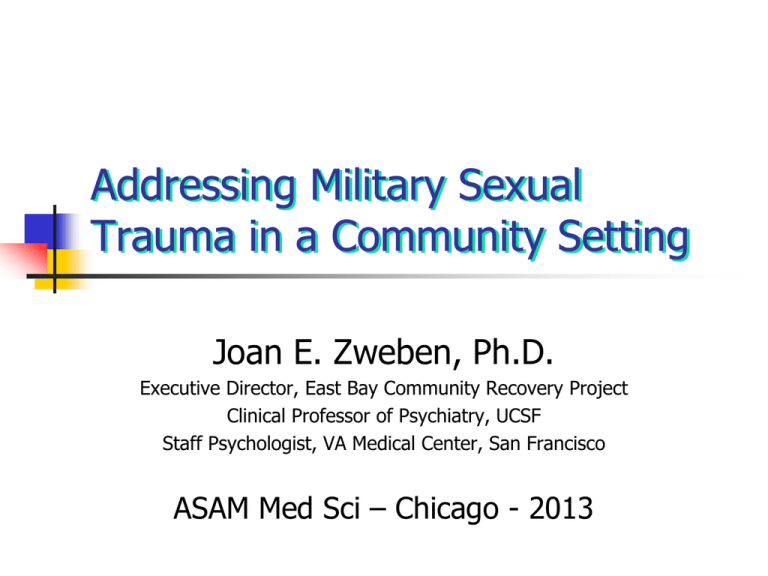
Addressing Military Sexual Trauma in a Community Setting Joan E. Zweben, Ph.D. Executive Director, East Bay Community Recovery Project Clinical Professor of Psychiatry, UCSF Staff Psychologist, VA Medical Center, San Francisco ASAM Med Sci – Chicago - 2013 Introduction Over 1 million active military are returning to the US Many will not seek help at the VA Are not aware of benefits Obstacles accessing benefits Negative feelings towards the VA Essential that community providers understand military culture and pt needs Definition “Military sexual trauma (MST) is sexual harassment and/or sexual assault experienced by a military service member regardless of the geographic location, the gender of the victim, or the relationship to the perpetrator. Both men and women can experience military sexual trauma and the perpetrator can be of the same or of the opposite gender. Perpetrators may or may not be service members themselves.” Total Victim Reports Gender Breakdown Barriers to Reporting Minimize seriousness, too embarrassed to report Fear of not being believed, being blamed, having reputation suffer Fear of harm or retribution if they report; fear for their career Concern their AOD use will undermine efforts to hold perpetrator accountable Screening - I “If you ask, they will answer” Create comfortable climate for disclosure Private setting Minimize interruptions Nonjudgmental posture Use unhurried speech Maintain good eye contact Screening II Often done by nurse or PCP Ask specific questions Heightened issues for women in maledominated setting such as the VA Manage/limit the disclosure process Assess current status and safety Watching for MST–Related Distress Power differential between patient and provider has parallels with the power differential between victim and perpetrator, triggering memories. How MST-related distress might present in a clinical (medical) setting: Anxiety Angry outbursts Irritability Avoidant behavior Re–experiencing Dissociation Health Problems and MST Chronic pain: back, pelvic, headaches Gynecologic – sexual dysfunction, menstrual abnormalities, menopausal sx, reproductive difficulties Gastrointestinal: diarrhea, indigestion, nausea, swallowing Other: chronic fatigue, sudden weight changes, palpitations Managing the Medical Encounter Make the medical encounter as safe as possible: Explain what to expect; provide private, calm setting Stop doing whatever triggered reaction (stop touching pt, discontinue procedure) Reorient and soothe pt Ground pt with concrete tasks Refer pt to mental health services Effective Treatments Recognize common psychological sx, including sx of complex trauma Be aware of commonly used medications Be aware of specific trauma treatments (SIT, Exposure, CPT, EMDR) Identify facilities with special resources for MST (specific staff or programs) Addressing Military Sexual Trauma in an Integrated Care Setting Learn about your nearby VA resources VA Care – A National Model Recent media coverage is about access, not quality of care Better quality; outcomes superior to Medicaid and private insurance Better safety; lowest rate of medical errors High rates of pt satisfaction VA Care Electronic records since mid 1980’s, used to track outcomes (user-made system) No incentive to overtreat Must plan for long term; can’t churn pts VA Care II Systematically looks for and reports its mistakes; errors more likely to come to public attention Leader in quality improvement and information technology Good model for delivery system changes (Phillip Longman, Best Care Anywhere: Why VA Health Care Would be Better for Everyone, 3rd Edition, 2012) Screening and Structure for Addressing MST All vets seen in VA healthcare are asked if they experienced MST All treatment for physical or mental health conditions related to MST is free Every VA health care facility has a designated MST coordinator who serves as a contact person for MST-related issues. Conclusion Community providers will see many of these pts Screening is essential Physicians benefit from highly focused training modules Aggregated resources are not the same as an integrated system of care Large systems need care managers to guide pt Slides www.ebcrp.org
